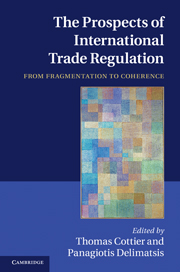Book contents
- Frontmatter
- Contents
- List of figures
- List of tables
- Contributors
- Preface and acknowledgements
- Table of cases
- List of abbreviations
- Introduction: fragmentation and coherence in international trade regulation: analysis and conceptual foundations
- PART I Constitutional issues in international trade regulation
- PART II Reforming specific areas of trade regulation
- 4 Reframing sustainable agriculture
- 5 Energy in WTO law and policy
- 6 Developing trade rules for services: a case of fragmented coherence?
- 7 Challenges of biotechnology in international trade regulation
- PART III ‘Trade and…’ linkages
- Index
- References
7 - Challenges of biotechnology in international trade regulation
from PART II - Reforming specific areas of trade regulation
Published online by Cambridge University Press: 26 April 2011
- Frontmatter
- Contents
- List of figures
- List of tables
- Contributors
- Preface and acknowledgements
- Table of cases
- List of abbreviations
- Introduction: fragmentation and coherence in international trade regulation: analysis and conceptual foundations
- PART I Constitutional issues in international trade regulation
- PART II Reforming specific areas of trade regulation
- 4 Reframing sustainable agriculture
- 5 Energy in WTO law and policy
- 6 Developing trade rules for services: a case of fragmented coherence?
- 7 Challenges of biotechnology in international trade regulation
- PART III ‘Trade and…’ linkages
- Index
- References
Summary
KEY MESSAGES
Biotechnology and multilayered governance
∙ Biotechnology offers an interesting case study in multilayered governance. While some regulatory aspects are best dealt with by harmonisation, other areas are best left to regulatory competition in light of diverging ethical perceptions and attitudes towards the potential risks of the technology.
∙ Coherent regulation combines harmonised and decentralised regulation in the field, depending upon the regulatory area.
Human rights and biotechnology
∙ Human rights cut both ways in substantive terms, with the exception of a clear ban on biological warfare. They both support and limit recourse to biotechnology. Human rights shape the process of balancing interests and values but do not offer clear guidance in the field.
∙ Human rights are of prime importance in procedural terms. They help in shaping appropriate legal avenues and participation in assessing biotechnology in research and commercial use.
Intellectual property rights and biotechnology
∙ Appropriate regulation of intellectual property rights in biotechnology varies and is not uniform.
Human genetic engineering is best dealt with by domestic regulation on the basis of broadly harmonised principles of intellectual property rights. Pluralist values and diverging ethical and moral perceptions of genetic engineering, and the advantages of making progress by trial and error, outweigh the advantages of harmonised rules and enhanced market access in international law.
∙ Animal genetic resources (AnGR) are key to modern breeding and biodiversity. They call for a new and appropriate regime. Analogies to plant genetic resources need to be looked at with caution as animal-related regulation functions against a fundamentally different background. […]
- Type
- Chapter
- Information
- The Prospects of International Trade RegulationFrom Fragmentation to Coherence, pp. 284 - 320Publisher: Cambridge University PressPrint publication year: 2011



